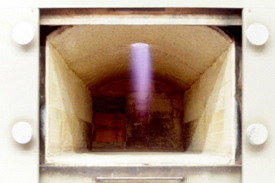For We are Dust...
As we go about our busy lives, it can sometimes be easy for the average person to overlook the simple fact that all terrestrial life is earth. From the iron in our blood to the calcium in our bones, our bodies are built from the very same elements and compounds that make up our planet. When we breathe in fresh air, the oxygen taken into our lungs from earth's atmosphere diffuses into our bloodstream and is carried to every cell in our body, and all of this is done without us even thinking about it.
 |
|
"...for dust you are and to dust you will return."
|
|
Similarly, millions of other microscopic processes function within our body every second and if the physical characteristics of earth were to change, even in slightest, life as we know it would be forever altered. This is how closely all life is tied to Mother Earth.
Although the Hebrew Bible (or Christian Old Testament) takes a more supernatural approach in answering the mysteries of life, few people--even those with a scientific background in chemistry or biology--could disagree with Genesis 3:19, which reads: "By the sweat of your brow you will eat your food until you return to the ground, since from it you were taken; for dust you are and to dust you will return.”
The Cremation Process
Cremation is the ancient funeral custom of returning the body to dust using fire. It is difficult to say exactly when humans began to cremate their dead, but it is known that this practice has been widely used by mankind since the Stone Age. Funeral pyres--large wooden structures designed specifically for ceremonial cremation rites--have traditionally been used in many world religions for thousands of years. Additionally, cremation was a common practice among the Ancient Greeks and Romans.
In order for cremation to occur, the body must be introduced to intense heat and flame (approximately 1,400 to 2,100 degrees Fahrenheit) for up to four hours depending on body size and mass. Movies and books have often portrayed the human body to be quite flammable, but in reality, about 60% of the entire human body is composed of water, which creates unique challenges for the cremation process. The proper mixture of oxygen and gas must be fed into the combustion chamber, or retort, at the correct rate to ensure efficient burning takes place.
 |
|
The cremation chamber, called a retort, heats to as high as 2,100 degrees Fahrenheit.
|
|
Once the actual cremation process has been completed, metal objects, either from clothing, jewelry or surgical implants will remain and must be separated. Since bone is composed mostly of calcium phosphate, which is a metallic compound, it cannot be reduced to ash from combustion alone. The bone must be processed by a pulverizing machine, called a cremulator, to crush the bone into a small and consistent size.
Every jurisdiction has its own laws concerning cremation. Many require a waiting period to expire, sometimes up to 24 hours or more from the time of death, before a person's body may be cremated. The waiting period is usually instituted for practical reasons. For one, the person in charge of final disposition arrangements must be given sufficient time to contemplate the decision to cremate because cremation is irreversible. Also, a physician, coroner, or medical examiner must be given enough time to determine that no foul play or criminal activity contributed to the person's death. The crematory must also receive written consent to cremate from a legal next of kin. Cremation cannot legally begin until this documentation has been properly filed with the appropriate governing authorities and the crematory. Most crematories in the Western world are highly regulated by professional and environmental authorities to ensure that cremations are handled safely with the utmost care and respect.
Cremation Today
Aside from religious beliefs, cremation is chosen by people today as a form of final disposition for many different reasons. Some people view cremation as a more simplistic alternative to traditional burial. Others take comfort in the wider variety of personalized memorial options available with cremation. For example, the cremated remains, or ashes, can be placed inside a personalized cremation urn or scattered in meaningful places. Small amounts of cremated remains can also be placed into small token sharing urns or worn inside cremation jewelry. Cremated remains can even be turned into diamonds or launched into outer space. Certainly, cremation provides options that are as unique as the person being remembered.
|